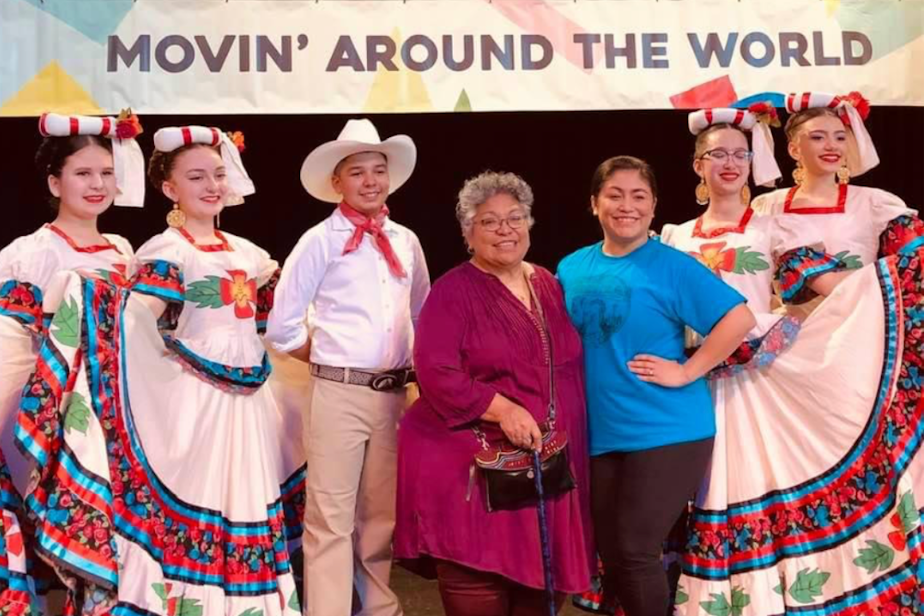Francisca Garcia, thank you for inspiring us to become artists

Last year, a pillar of Seattle’s Mexican-American artist community passed away.
Francisca Garcia was well known for making the annual Día de los Muertos ofrenda at El Centro de La Raza in Beacon Hill, as well as curating ofrendas for other events, like Folklife, and the opening of the Sea Mar Museum of Chicano Chicana Latino Latina Culture.
She also spent eight years as manager of the Rainier Arts Center.
RadioActive's Josefina Gonzalez, a young artist herself, tells the story of what’s been lost and how to move forward.
[RadioActive Youth Media is KUOW's radio journalism and audio storytelling program for young people. This story was entirely youth-produced, from the writing to the audio editing.]
T
housands of years ago, the Library of Alexandria burned down. It was full of so much wisdom, its loss left a hole in all of Egypt.
Well, that’s what’s been lost in my community. Except we’ve lost a leader who was full of passion, knowledge, wisdom and so much more. Francisca Garcia was our Alexandria.
Garcia was a force of nature. She would be bouncing around at every event with Mexican-American artists, giving speeches and hugging everyone.
Sponsored
Veronica A. Gallardo is the property manager at El Centro de la Raza in Seattle. She and Garcia were close friends and colleagues. Gallardo says Garcia was patient and loving.
"She was so funny," Gallardo said. "I think she just had a great laugh and smile."
Last year, we were all left heartbroken at Garcia’s unexpected passing.
I’m a dancer in this community and I saw Garcia everywhere. Losing her was something everyone I knew was feeling. Even if you didn’t know her, someone you knew did.
Sponsored
RELATED: How my best friend and I stay connected to our culture through dance
Garcia influenced a lot of young Seattle artists, like Aurelio Valdez. Valdez is a young Mexican-American hip hop artist in Seattle. Garcia made a personal difference in his life.
Valdez says he has always struggled with his cultural identity.
"You know, cause I am Chicano, I'm Mexican-American. I'm not Mexican enough for the Mexicans. I'm definitely not American enough for the Americans," he said.
Valdez met Garcia in 2017 while working in a collaborative artists space. Their friendship grew stronger over the years.
Sponsored
"And the first song that I ever wrote and released, [Garcia] heard it before it even was released and she cried," Valdez said. "And she was like, 'Yo, like, I never heard a song that, like, perfectly embodied my identity.'"
Garcia’s support meant a lot to Valdez, especially as a young artist. He saw how folks of all ages could love and relate to his music. He said how beautiful it is when people of different generations can collaborate and celebrate art together.
Every word Garcia spoke was a lesson. I remember being 10 and making mini ofrendas with her. She would get so mad if you called them “alters.” I always felt like she was keeping us aware of our language and reminding us that how we say things matters.
"She made sure that she used the proper words," Gallardo said. "She was like, 'We don't say altar. We say ofrenda!'"
The word "ofrenda" means offering. They are the centerpiece of Dia de los Muertos.
Sponsored
You’re never gonna see the same ofrenda twice. They come in all shapes and sizes. Some can be as small as a shoe box and others can be as large as a full dining room table.
They will always have pictures of our passed loved ones. People keep marigolds in their homes to help guide the spirits home. It is an offering to welcome back our family who has passed.
Ofrendas make them feel at home. We put things on them that our loved ones might miss in the afterlife. Some people put candy, some put cigarettes. When our family comes back they take the essence of these items and leave the physical items behind.
Garcia pushed us to keep our culture alive and to keep the Mexican in the Mexican-American. She believed that art is for everyone.
Gallardo said the lesson Garcia gave the community is that art is for everyone, in all forms —in dance, in paintings, in the ofrenda as an art form.
Sponsored
Art, Gallardo said, "comes in a variety of forms everybody can enjoy. But when you put it together in the ways that [Garcia] put it together for Dios de los Muertos, it becomes its own living art."
Garcia's passion for art was contagious. She influenced so many younger artists.
I wish she could witness the art that we’re going to produce. Because we are just getting started.
Francisca, nosotros los artistas del futuro le agredecmos por su ayuda y amor inconditional, que descanse en paz y poder.
This story was produced in a RadioActive Youth Media Advanced Producers workshop for high school and college-age youth. Production assistance by Kyle Norris. Edited by Kamna Shastri. Prepared for the web by Kelsey Kupferer.
Find RadioActive on Instagram, TikTok, YouTube and Facebook, and on the RadioActive podcast.
Support for KUOW's RadioActive comes from the Bill & Melinda Gates Foundation Discovery Center and BECU.



